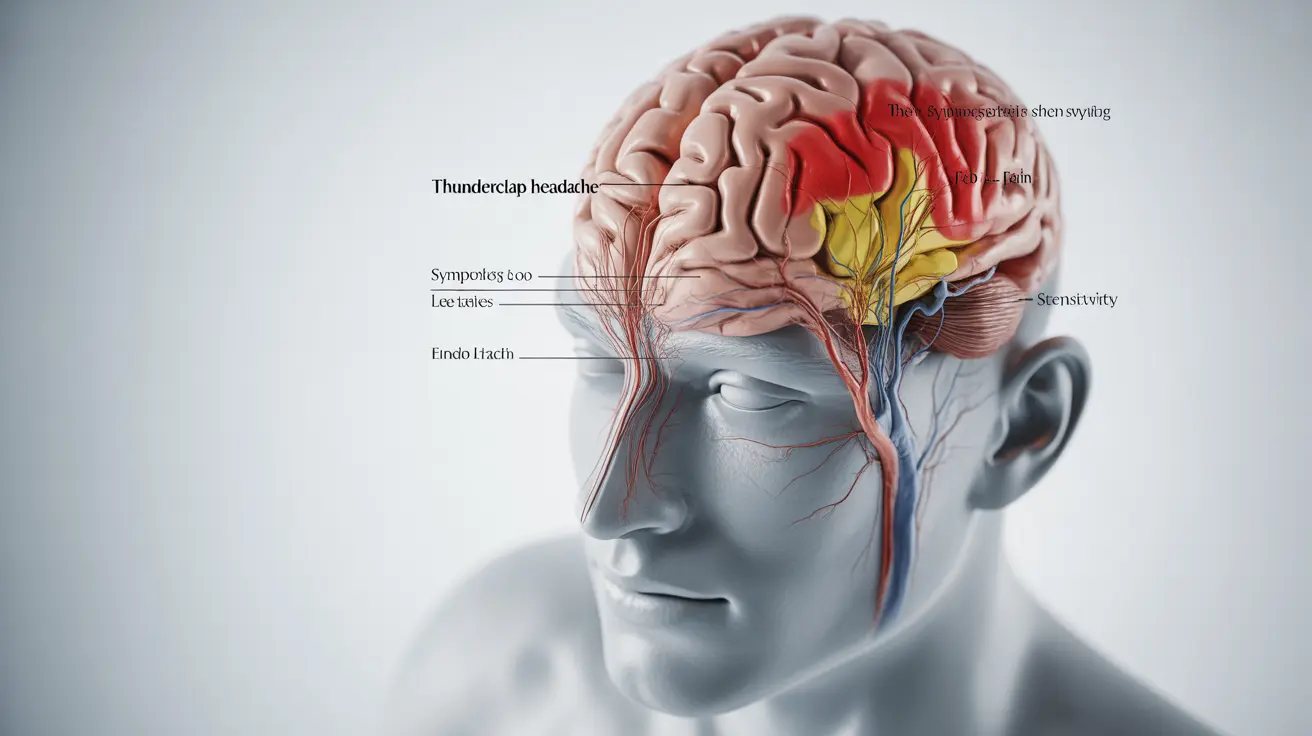A thunderclap headache is a severe and sudden headache that reaches maximum intensity within 60 seconds, often described as the worst headache of one's life. This type of headache requires immediate medical attention as it can signal serious underlying conditions that need urgent evaluation.
While some headaches develop gradually, thunderclap headaches strike without warning and demand emergency care. Understanding their symptoms, causes, and proper response can be crucial for preventing potentially life-threatening complications.
Key Characteristics and Symptoms
Thunderclap headaches have distinct characteristics that set them apart from other headache types:
- Explosive, severe pain reaching peak intensity within one minute
- Pain often described as crushing or similar to being struck by lightning
- Usually affects the entire head rather than one side
- May be accompanied by nausea and vomiting
- Can cause sensitivity to light and sound
- May lead to altered consciousness or confusion
Underlying Causes and Medical Significance
Several serious conditions can trigger a thunderclap headache:
- Subarachnoid hemorrhage (bleeding in the brain)
- Blood vessel problems like aneurysms or arterial dissection
- Severe blood pressure spikes
- Reversible cerebral vasoconstriction syndrome (RCVS)
- Pituitary apoplexy
- Cerebral venous thrombosis
The potential severity of these underlying causes makes immediate medical evaluation essential for anyone experiencing a thunderclap headache.
Diagnostic Process
When evaluating a thunderclap headache, medical professionals typically follow a comprehensive diagnostic approach:
Immediate Assessment
- Detailed medical history
- Physical and neurological examination
- Blood pressure monitoring
- Assessment of mental status
Imaging Studies
- CT scan of the head
- MRI with contrast
- CT angiography
- Lumbar puncture (if needed)
Emergency Response and Treatment
The appropriate response to a thunderclap headache involves several critical steps:
- Seek immediate emergency medical care
- Call 911 or have someone drive you to the nearest emergency room
- Note the time of onset and any accompanying symptoms
- Avoid taking pain medications until evaluated by a medical professional
- Be prepared to describe the pain's characteristics and intensity
Risk Factors and Triggers
While thunderclap headaches can occur without warning, certain factors may increase risk or trigger an episode:
- Physical exertion
- Sexual activity
- Sudden emotional stress
- Exposure to extreme temperatures
- Certain medications or supplements
- History of blood vessel disorders
Frequently Asked Questions
What are the most common symptoms that indicate a thunderclap headache? A thunderclap headache is characterized by sudden, severe pain that peaks within 60 seconds, often described as the worst headache ever experienced. It typically affects the entire head and may be accompanied by nausea, vomiting, and sensitivity to light and sound.
What causes a thunderclap headache and how serious is it? Thunderclap headaches can be caused by various serious conditions, including brain bleeding, aneurysms, blood vessel problems, or severe blood pressure spikes. They are considered medical emergencies due to their potential to indicate life-threatening conditions.
How is a thunderclap headache diagnosed and why is emergency treatment important? Diagnosis typically involves immediate brain imaging (CT scan or MRI), physical examination, and possibly additional tests like lumbar puncture. Emergency treatment is crucial because thunderclap headaches can indicate conditions that require immediate intervention to prevent severe complications or death.
What should I do immediately if I experience a thunderclap headache? If you experience a thunderclap headache, seek emergency medical care immediately. Call 911 or have someone take you to the nearest emergency room. Do not wait to see if it improves on its own or try to treat it with over-the-counter medications.
Can activities like exercise or coughing trigger a thunderclap headache? Yes, physical activities including exercise, coughing, sexual activity, and sudden emotional stress can trigger thunderclap headaches in some cases. However, this doesn't make them any less serious, and they still require immediate medical evaluation.




